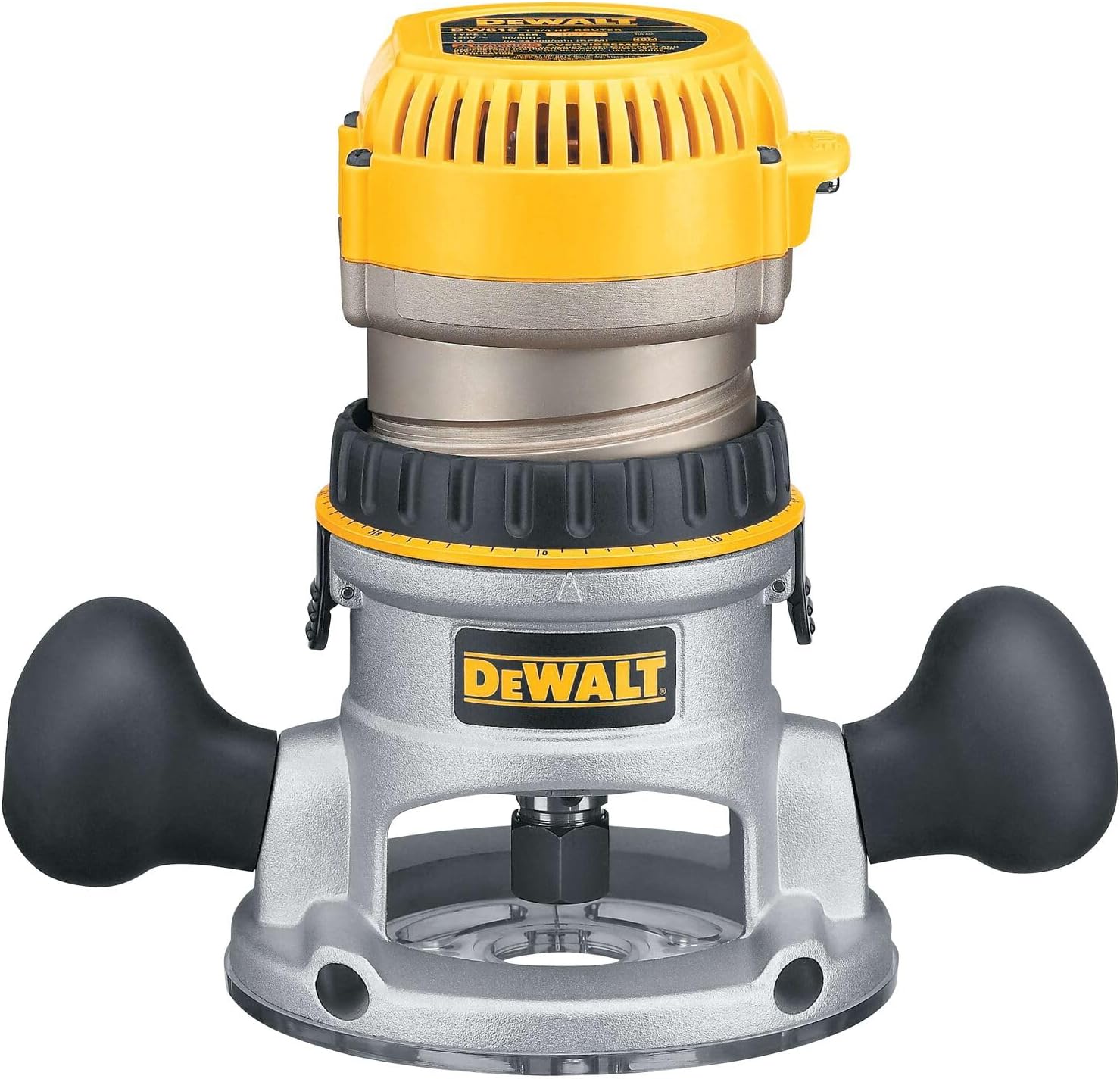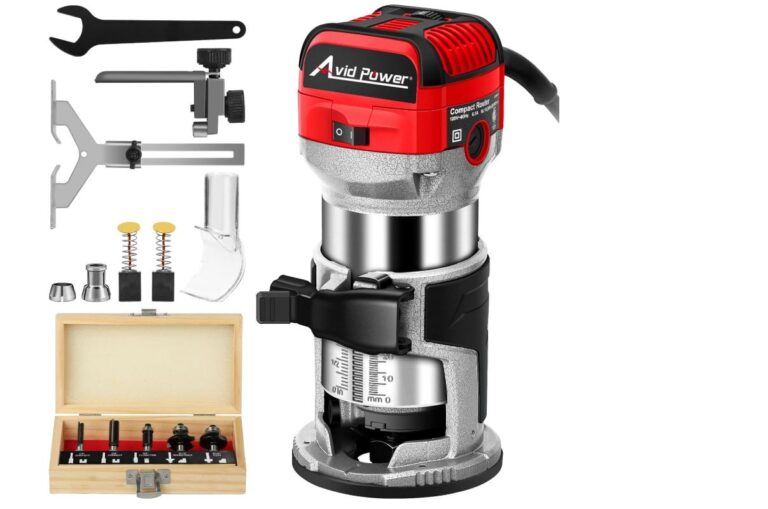Looking for the best fixed base router for woodworking? A fixed base router is one of the most reliable tools for clean, accurate cuts and smooth finishes.
Whether you’re a beginner or a pro, the right router makes trimming, edging, and shaping wood much easier.
In this guide, we’ll review the top 5 fixed base routers for woodworking, compare their features, and help you pick the one that fits your projects and budget.
When you’re first getting into woodworking, the world of power tools can be overwhelming. You’ve got your table saw, your miter saw, and then… the router.
5 Best Fixed Base Routers for Woodworking (Product Reviews)
Choosing the perfect fixed-base router can feel like a daunting task, but it all comes down to finding a tool that matches your projects, skill level, and budget.
While many brands offer great options, six stand out as consistent top performers, each bringing something unique to the workshop.
From powerful workhorses to lightweight precision tools, this detailed review will help you decide which fixed-base router is the best fit for you.
5.1 Bosch 1617EVS Fixed Base Router Review

The Bosch 1617EVS is a true legend in the woodworking community. For decades, it has been the go-to router for both hobbyists and professionals who demand power, precision, and reliability in a single package. Its classic design and proven performance have made it an industry standard.
- Features: This router is built around a robust 2.25 HP, 12-amp motor. It comes with variable speed control, allowing you to dial in the perfect RPM from 8,000 to 25,000 to match different materials and bits. A soft-start feature ensures the motor spools up smoothly, preventing any lurching on startup. Its iconic dual wooden handles provide a comfortable and secure grip, and its durable aluminum motor housing is designed for years of heavy use. A key feature for anyone planning to use it in a router table is the ability to adjust the bit height from above the table, which is a massive time-saver.
- Pros & Cons: The Bosch 1617EVS offers a host of advantages that make it a favorite in the workshop.
- What we love about it: It has the perfect balance of power and features, making it incredibly versatile for both handheld and router table use. Its classic wooden handles are comfortable and provide excellent control. The soft-start and variable speed are essential for professional-quality work.
- What could be better: At around 11 pounds, it’s a bit heavy for extended handheld use, which can lead to fatigue. Some users also note that the on/off switch can be prone to collecting sawdust when used in a router table.
- Best for: DIY and professional use: This router is a fantastic all-arounder. Its balance of power, features, and durability makes it an excellent choice for a wide range of projects, from DIY furniture building to professional cabinetmaking. If you’re looking for one router that can do it all, the Bosch 1617EVS is a top contender.
5.2 DEWALT DW616 Fixed Base Router Review

The DEWALT DW616 is a no-nonsense, dependable workhorse. It’s the kind of tool that gets the job done without a lot of bells and whistles. Its simple, rugged design and consistent performance have earned it a loyal following among woodworkers who prioritize reliability.
- Features: The DW616 is powered by an 11-amp, 1-3/4 HP motor. Unlike many modern routers, it’s a single-speed machine that operates at a fixed 24,500 RPM. While it lacks variable speed, its constant RPM is a major advantage for repeatable tasks where you need uniform cuts. It features a micro-fine depth adjustment ring that allows for precise height changes, accurate to 1/64 of an inch. A quick-release motor latch makes it easy to switch bases or change bits.
- Pros & Cons: The DEWALT DW616 is a powerhouse of consistency and dependability.
- What we love about it: Its rugged, simple design is incredibly durable. The fixed speed is a huge advantage for repetitive tasks, as you never have to worry about the speed changing. Its micro-fine depth adjustment is highly accurate, and the tool-free latch makes it easy to work with.
- What could be better: The biggest trade-off is the lack of variable speed, which limits its use with a variety of materials or larger bits. It also doesn’t have a soft-start feature, so it can lurch on startup. The on/off switch can be a little hard to reach when manually operating the router.
- Best for: Precise trimming and edge routing: The DEWALT DW616 excels at tasks where you need consistent, predictable performance. Its fixed speed makes it ideal for running flush-trim bits, cutting dadoes, or putting a roundover on a long edge. If your projects primarily involve these kinds of cuts, this router’s simplicity and reliability are a major asset.
5.3 Makita RT0701C Compact Fixed Base Router Review

The Makita RT0701C is a favorite for those who value precision and portability over sheer power. This compact router is often called a “palm router” due to its small size and comfortable, one-handed operation. It proves that great things can come in small packages.
- Features: The RT0701C features a 1-1/4 HP, 6.5-amp motor. Don’t let the smaller motor fool you; this little router is packed with features. It comes with variable speed control, allowing you to dial in the perfect RPM from 10,000 to 30,000. Its smooth rack-and-pinion depth adjustment system makes fine-tuning the bit height a breeze. This router is part of a larger system that allows the user to buy a single motor and swap between a fixed base, plunge base, and tilt base, making it incredibly versatile.
- Pros & Cons: The Makita RT0701C offers a ton of value in a compact form factor.
- What we love about it: Its lightweight and ergonomic design make it perfect for one-handed operation and detail work. The variable speed control is a huge advantage, and the smooth depth adjustment is incredibly precise. It’s an excellent choice for on-site work due to its portability.
- What could be better: Its limited power means it’s not suitable for heavy-duty tasks or large bits. Its smaller 1/4-inch collet also limits the size and variety of bits you can use. It’s a specialist tool, not a workhorse.
- Best for: Lightweight and portable woodworking: This is the perfect router for hobbyists, woodworkers with limited space, or anyone who needs a precise tool for smaller-scale projects. It’s ideal for edge trimming, hinge mortising, and other tasks that require a high degree of control in a small package.
5.4 Porter-Cable 690LR Fixed Base Router Review

The Porter-Cable 690LR is another old-school classic that has earned a reputation as a dependable workhorse. Its simple, robust design and consistent performance have made it a favorite among beginners and those who appreciate a no-frills, rugged tool.
- Features: The 690LR features a 1-3/4 HP motor with a fixed speed of 27,500 RPM. It’s a single-speed tool, much like the DEWALT DW616. Its durable cast aluminum base and dual handles are designed for stability and control. The motor can be easily removed from the base, making bit changes and adjustments straightforward.
- Pros & Cons: The Porter-Cable 690LR is a no-nonsense tool built to last.
- What we love about it: Its legendary durability means it will be a reliable workhorse for years. The simple design is perfect for beginners and for use in a router table, as there are no complicated features to worry about. Its solid feel and dual handles provide excellent control.
- What could be better: The lack of variable speed and a soft-start feature are significant drawbacks compared to more modern routers. While it’s a dependable tool, its technology is a bit dated compared to newer models.
- Best for: Beginners and affordable woodworking setups: This router is an excellent choice for a first-time buyer. Its straightforward design and reliable performance provide a great learning experience. It’s a fantastic value for money and a dependable tool that can handle a wide range of common routing tasks.
5.5 SKIL 14 Amp Fixed Base Router Review

The SKIL 14 Amp fixed-base router stands out by offering a lot of power and features at a very competitive price. It’s a great option for the budget-conscious woodworker who doesn’t want to compromise on performance.
- Features: The SKIL router boasts a powerful 14-amp, 2.5 HP motor, putting it in the same class as some professional-grade routers. It comes with variable speed control, an LCD screen that displays the RPM, and a convenient soft-start feature. A unique feature is the “wood type” setting on the LCD, which suggests the optimal speed for your material. It is also often sold as a combo kit with a plunge base, offering incredible value.
- Pros & Cons: The SKIL router offers incredible value for the money.
- What we love about it: You get a lot of horsepower and features for a fraction of the cost of some other brands. The variable speed and soft-start are excellent features, and the combo kit option makes it incredibly versatile. The LCD screen is a nice modern touch.
- What could be better: Its build quality isn’t quite as refined as that of premium brands, and the digital controls can sometimes be a bit finicky. It may not hold up to the rigors of a professional shop as well as more expensive options.
- Best for: Budget-friendly option with decent power: This router is a fantastic choice for anyone who wants a powerful, feature-rich tool without spending a premium. It’s an ideal step up for a woodworker who has outgrown their small trim router and needs more power for demanding projects.
5.6 Metabo HPT M12VC Fixed Base Router Review
The Metabo HPT M12VC is a fantastic choice for those who value a quiet, controlled working environment. While many routers sound like a jet engine taking off, this model is designed to be a silent partner in the workshop, making it ideal for home use and for projects that require a more peaceful atmosphere.
- Features: This router is powered by an 11-amp, 2.25 HP motor. Its most notable feature is its low noise level, operating at less than 79.5 decibels (dB), which is significantly quieter than most routers. It comes with variable speed control, allowing you to set the speed between 8,000 and 24,000 RPM. The 2-stage motor release clamp makes depth adjustments quick and easy, while the electronic speed control maintains a constant RPM under different loads. It also comes with a generous 5-year warranty.
- Pros & Cons: The Metabo HPT M12VC offers a unique blend of power and quiet operation.
- What we love about it: Its low noise level is a huge advantage for home workshops and prolonged use. The router is powerful enough to handle most common woodworking tasks with precision and control. The 5-year warranty provides peace of mind.
- What could be better: The depth adjustment is not as precise as on some other models, which can be a frustration for fine joinery. Users also report that the bits fit very tightly, making them difficult to change and potentially causing the motor’s brushes to wear out more quickly. There have also been occasional complaints of the motor burning out after a few months.
- Best for: Quiet woodworking projects and home use: This is the perfect router for anyone who is sensitive to noise or who works in a shared space where noise is a concern. It provides all the necessary power for a wide range of projects, all while keeping the noise level to a minimum.
How to Choose the Best Fixed Base Router
Selecting the right fixed-base router is a crucial decision that will impact your woodworking projects for years to come. With so many options on the market, it’s easy to get lost in the specifications. To find the perfect tool for your needs, you should focus on several key factors that define a router’s performance, safety, and comfort.
Power and motor capacity (HP & RPM)
The power of a router is measured in horsepower (HP) and its speed in revolutions per minute (RPM). These two metrics are the heart of the tool’s performance.
- Horsepower (HP): For a fixed-base router, the horsepower rating tells you how well the motor can handle tough materials without “bogging down” or losing speed. For small projects and softwoods, a 1-1/2 HP router is often sufficient. However, if you plan on working with hardwoods like oak or maple, or if you’ll be using larger router bits for big profiles or joinery, a router with 2 HP or more is a wise investment. More power means smoother, more consistent cuts and less strain on the motor.
- Revolutions Per Minute (RPM): The speed of the router bit is just as important as its power. High RPMs lead to cleaner, smoother cuts with less tear-out, especially on hardwoods and veneers. Many fixed-base routers come with variable speed control, which is a highly desirable feature. It allows you to adjust the RPM to match the specific material and the size of the bit you’re using. Larger diameter bits (like panel raisers) should be run at slower speeds to prevent overheating and kickback, while smaller bits can run at a faster speed for a smoother finish.
Collet size and bit compatibility
The collet is the part of the router that holds the bit. It’s the single most important factor for bit compatibility and tool versatility. The two most common collet sizes are 1/4 inch and 1/2 inch.
- 1/4-inch collet: These are great for small, detail-oriented projects and are the standard for most small, handheld routers. The bits are generally less expensive, but the small shank size can lead to bit deflection, especially with larger bits.
- 1/2-inch collet: This is the gold standard for most woodworking tasks. The thicker shank of a 1/2-inch bit provides superior strength and stability, reducing vibration and ensuring a cleaner cut, particularly in hardwoods. A 1/2-inch collet can also hold 1/4-inch bits by using a collet reducer sleeve. My advice? Look for a fixed-base router that comes with both a 1/4-inch and a 1/2-inch collet. This gives you the best of both worlds and ensures that your router can handle any bit you throw at it.
Base design and stability
The base of a fixed-base router is its foundation, and its design has a huge impact on your ability to control the tool.
- Standard Base: Most fixed-base routers come with a standard circular or square base that you guide with two hands. A wider base provides more stability and helps prevent the router from tipping during a cut.
- D-handle Base: Some fixed-base routers have a D-shaped handle with a trigger switch. This design offers an incredibly comfortable and secure grip, which can reduce fatigue and improve control, especially for long edge-profiling jobs.
- Router Table Compatibility: If you plan on mounting your fixed-base router in a router table, look for a model that has an easy-to-use depth adjustment from above the table.
Ergonomics and ease of use
A router can be a heavy tool, so its ergonomics are a huge factor in preventing user fatigue and ensuring a safe, comfortable working experience.
- Grip and Handle Placement: The handles should feel comfortable in your hands and allow you to hold the router securely.
- Switch Location: The on/off switch should be easy to reach and operate without having to adjust your grip.
- Ease of Depth Adjustment: The locking lever or knob should be easy to loosen and tighten, and the micro-adjustment dial should feel smooth and responsive.
Dust collection system
Routing produces a massive amount of dust and wood chips. A good dust collection system is essential for both a clean workspace and for your health. Look for a fixed-base router that has a dedicated dust collection port that can be easily connected to a shop vacuum or dust collector. This not only keeps the air clean but also improves your visibility of the cutting line, which is critical for precision work.
Price and brand reliability
Finally, consider the price and the reputation of the brand. While it’s tempting to go with the cheapest option, investing in a reputable brand like Bosch, Makita, DeWalt, or Porter-Cable is a smart decision. These brands are known for their quality, durability, and excellent customer support. A reliable brand will also have a wide network of service centers and easily available replacement parts.
This incredibly versatile tool is a true workhorse, capable of everything from creating decorative edges on furniture to cutting precise joints for cabinetry. While many people are familiar with the more flashy plunge router, which can “plunge” a bit into the middle of a piece of wood, the fixed-base router is the unsung hero of many workshops.
So, why is a fixed-base router so essential? It’s all about precision and simplicity. Imagine you need to make a dozen identical cuts for a project perhaps a perfect roundover on a set of cabinet doors or a series of matching dadoes for a bookshelf. With a fixed-base router, you set the depth of the cut, lock it in place, and you’re ready to go. There’s no risk of the depth changing mid-cut, no spring-loaded mechanism to fight against. This makes it the go-to tool for repetitive, high-accuracy tasks where consistency is paramount. While a plunge router offers amazing versatility, a fixed-base router offers unmatched reliability for the jobs it was designed for. In essence, it does one thing exceptionally well: maintain a rock-solid, fixed cutting depth. This focus on a single, core function makes it a must-have for both beginners and seasoned pros who demand predictable, repeatable results every single time.
What is a Fixed Base Router?
At its core, a fixed-base router is a type of power tool that has a motor and a collet to hold the router bit. The key distinguishing feature, as its name suggests, is a base that is “fixed” in relation to the motor. The bit’s cutting depth is set by adjusting the motor up or down within this base and then locking it securely in position. Once that depth is set, it will not change during the cut.
This seems like a simple concept, but it’s what makes the tool so effective. Unlike a plunge router, which has a spring-loaded mechanism that allows the motor to move up and down in a controlled manner, the fixed-base router’s motor is locked solid.
So, what are the key features that make it so beginner-friendly and precise?
- A Solid, Non-Moving Base: This design provides exceptional stability and control. When you’re running the router along an edge, you’re not fighting against a spring mechanism. This gives you a better feel for the tool and helps you keep the cut straight and true. For beginners, this is a huge confidence booster, as it reduces the risk of the router “tipping” or deviating from its path.
- Simple, Secure Depth-Locking Mechanism: The process of setting the bit depth is usually very straightforward. You loosen a lever or a knob, adjust the motor up or down, and then tighten it again. Many models also include a micro-adjustment dial that allows for incredibly precise, small changes to the bit’s height—often in increments of 1/64″ or less. This level of fine-tuning is crucial for tasks where even a tiny variation can ruin a joint or a decorative profile.
- Compact and Lightweight Design: Since a fixed-base router lacks the heavy, bulky springs and telescoping arms of a plunge router, it’s typically lighter and more compact. This makes it easier to handle with one hand and reduces user fatigue during long projects. These smaller models, often called “palm routers,” are perfect for detailed work, edge trimming, and small-scale projects. Their straightforward design is not just a convenience; it’s a fundamental part of what makes them so reliable and easy to master.
Benefits of Fixed Base Routers for Woodworking
The true value of a fixed-base router becomes apparent when you consider its practical benefits in the workshop. These advantages are why many woodworkers, from hobbyists to seasoned professionals, choose to have at least one and often several fixed-base routers in their tool collection.
Consistency in Cuts
For any project that requires repetitive cuts, a fixed-base router is the undisputed champion. Whether you’re cutting a series of dadoes for a bookshelf, a rabbet for a cabinet back, or a chamfer on a tabletop, you can be certain that every single cut will be the same depth. This is its single most important benefit. The locked depth eliminates any chance of the router bit creeping up or down, ensuring that your joinery fits perfectly and your decorative profiles are uniform across the entire project. This level of repeatability is a major time-saver and a quality-booster, as it eliminates the need for constant re-measurement and adjustment.
Durability and Control
Due to their simpler design, fixed-base routers are incredibly durable. With fewer moving parts, there’s less to go wrong, which means they hold up well to the rigors of a busy workshop. This rugged simplicity translates directly into superior control for the user. The lower center of gravity and stable base mean the tool feels solid in your hands, allowing you to guide it with confidence. This is especially important for edge routing, where a clean, unwavering line is essential. The handles are often positioned low on the body, giving you a better feel for the work surface and making it easier to maintain a smooth, even pass. This combination of stability and control is a key factor in achieving professional-looking results.
Affordability for Hobbyists and Professionals
A fixed-base router is often the most budget-friendly option for a first-time router purchase. Because the internal mechanism is less complex than that of a plunge router, manufacturers can produce them at a lower cost, passing the savings on to you. For a hobbyist on a budget, this makes a fixed-base model an excellent entry point into the world of routing.
For professionals, this affordability offers a different kind of benefit: the ability to have multiple routers set up for different jobs. Imagine you have a large project with several different router bit profiles. Instead of constantly changing bits on a single router, you can have a separate fixed-base router dedicated to each task. One might be permanently mounted in a router table with a large profile bit, another might be set up for a specific roundover on a handheld base, and a third could be ready for a flush-trimming job. This saves an immense amount of time and streamlines the workflow, making the fixed-base router a highly cost-effective solution for a high-production shop.
In conclusion, while the plunge router is celebrated for its versatility, the fixed-base router is the quiet workhorse of the woodworking world. It’s the tool you reach for when you need to get a job done right the first time, every time. Its focus on a single, fixed depth provides a level of precision, consistency, and control that is unmatched, all within a durable and affordable package. For any woodworker looking to build a reliable tool collection, the fixed-base router is an absolutely essential starting point.
The following video provides an excellent visual demonstration of the differences between plunge and fixed-base routers.
Comparison Table: Best Fixed Base Routers
While it’s not possible to display a literal table here, imagine a side-by-side comparison of the top fixed-base routers on the market. Such a table would be an invaluable resource, allowing you to quickly compare the key specifications of each model.
- Motor Power: This column would show the horsepower rating, helping you quickly identify routers suitable for light-duty (1-1/4 HP) or heavy-duty (2+ HP) tasks.
- RPM Range: You would see the minimum and maximum speeds, highlighting whether the router is a single-speed or a variable-speed model.
- Price Range: This column would give you a general idea of the cost, from budget-friendly options to professional-grade tools.
- Weight: The weight of the router would be listed, helping you decide if the tool is suitable for handheld use or if it’s better for a router table.
- Best Use Case: This column would provide a quick recommendation, such as “Perfect for Edge Profiling” or “Ideal for Router Table Use.”
For example, a table might compare the Makita RT0701C (a compact, 1-1/4 HP router perfect for handheld use) with the Bosch 1617EVS (a 2-1/4 HP router that’s a workhorse for both handheld use and router tables). Such a comparison is a great way to distill all the information into a single, easy-to-read format.
Best Fixed Base Router for Beginners
For a woodworker just starting out, the best fixed-base router is one that is easy to control, affordable, and reliable. You don’t need the most powerful machine on the market; you need a tool that won’t intimidate you and will help you build confidence in your skills.
Easy to control and budget-friendly choices
- Compact Models: The best fixed-base router for a beginner is often a smaller, lighter model, sometimes called a “trim router” or “palm router.” These tools are less cumbersome and easier to guide, making them ideal for simple tasks like rounding over an edge or cutting a small dado. Their simple, ergonomic design means you can get a feel for the tool without fighting against a heavy motor.
- Affordable Price Point: A beginner should look for a router in the $80 to $150 price range. This gives you a quality tool from a reputable brand without a huge financial commitment. Brands like DeWalt, Makita, and Bosch offer excellent entry-level models that provide a great balance of power and ease of use.
- Variable Speed: Even for a beginner, a variable-speed router is highly recommended. It gives you the flexibility to work with a variety of materials and bit sizes, preparing you for more advanced projects down the line.
Best Fixed Base Router for Professionals
For a professional woodworker, a fixed-base router is a tool they use every single day, so it needs to be powerful, durable, and precise.
Powerful motors and long-term durability
- High Horsepower: A professional will need a router with at least 2 HP, and often up to 3 HP, to handle demanding tasks in hardwoods. A powerful motor won’t bog down under load, which is essential for consistent, high-quality work.
- Precision and Reliability: Professionals rely on their tools to perform flawlessly, so a router with a precise micro-adjustment system and a robust locking mechanism is a must. They also need a tool that can stand up to the rigors of a busy workshop, which means looking for models with a heavy-duty motor, durable bearings, and a rugged body.
- Interchangeable Bases: Many professional-grade routers are sold in a combination kit that includes both a fixed base and a plunge base. This is the ultimate in versatility and is a smart choice for a professional who needs a single motor that can handle all types of routing tasks.
Fixed Base vs. Plunge Router: Which One Should You Buy?
This is one of the most common questions in woodworking. Both types of routers are incredibly useful, but they excel at different things. The best choice depends on the kind of work you plan on doing.
Key differences
- Fixed Base Router: The fixed-base router is the master of consistency and stability. It’s the tool you use for tasks where you need a consistent depth of cut from start to finish. It’s perfect for edge profiling, dadoes, rabbets, and for use in a router table.
- Plunge Router: The plunge router is the master of versatility and control. Its defining feature is the ability to plunge the bit into the wood. This makes it the ideal tool for tasks that start in the middle of a board, such as cutting mortises, inlay work, or grooves for splines.
Which is better for woodworking projects
- For the Hobbyist: If you’re a beginner, start with a fixed-base router. It’s more affordable, easier to use, and it’s the right tool for the vast majority of common woodworking tasks. You can always add a plunge router to your collection later.
- For the All-Around Woodworker: The best solution is often a combination kit. These kits come with a single motor and two interchangeable bases—one fixed and one plunge. This gives you the best of both worlds, allowing you to quickly switch between edge routing and plunge cuts without having to buy a second router. It’s the most versatile and cost-effective option for anyone who wants to tackle any project.
Router Safety Tips for Woodworkers












